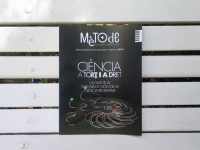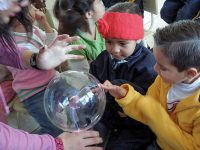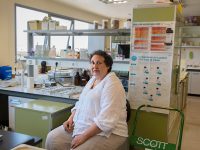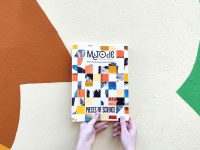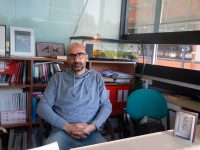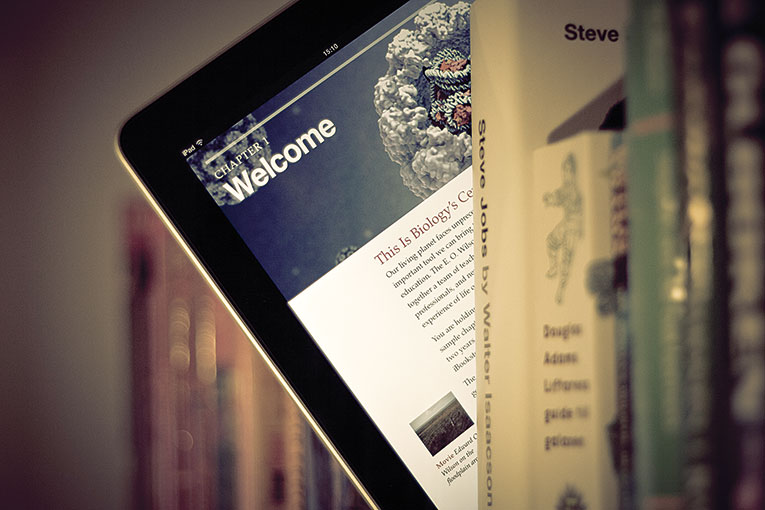
| Popular science finds itself in a new scenario where a shortage of information has been replaced by abundant and often freely available knowledge sources. Although often produced by amateurs, such information may be of a similar or even better quality than that produced professionally. Consequently, there is greater collaboration between professionals and amateurs, making it more difficult to distinguish between them.
Keywords: copyright, popular science, amateur, professional, business model. |
||
|
Collaboration between peers is a low-level form of competition, even friendly competition, which strengthens their sense of belonging. People who work together to accomplish a common goal often strive to do better than their colleagues, so as to be accepted by their peers or considered better by others. Thus, collaboration boosts talent, a phenomenon described as commons-based peer production (Benkler, 2006), leading to common Internet projects such as Wikipedia, OpenStreetMap (a free editable map), GNU/Linux, free open universities like Udacity, the citizen platform FixMyStreet set up to improve neighbourhoods, as well as peer-to-peer file sharing networks (p2p). Naturally, some people do not really collaborate at all while others may even try to boycott the project (such as the attempts to sabotage Wikipedia), but most people simply do their bit, which may not be much individually but it all adds up. However, according to the Pareto principle (also known as the 80-20 rule) all cooperation driven by such competition may involve a small group of people who are highly active, in other words «a few contributing a lot» and «a lot contributing a little». For example, on Twitter, 2% of users are responsible for posting 70% of all messages on the network. The proportion of active users may be small, but Wikipedia or Twitter have literally millions of users and, therefore, these committed and highly active users represent a considerable number all told (Shirky, 2012). This is what Eric von Hippel –economist at the Massachusetts Institute of Technology– calls «advanced user-driven innovation» (Hippel, 1986). However, for collaboration to be truly fruitful between more or less advanced and more or less committed users, who have varying levels of expertise, we must take into account the structure of the peer network in question which must incorporate diversity, independence and freedom (Surowiecki, 2005). In popular science, the Internet reveals that –despite having some advantages like intellectual or professional credit– individual authorship falls far short of collective authorship: collaborative circles, contributions from advanced readers, instant improvement, expansion and update of contents, fresh approaches… This phenomenon occurs in the real (physical) world, when users of specific tools explore them and discover new uses or functions that the original designers had overlooked. Users of Web 2.0 share their findings and in doing so give rise to greater innovations than those proposed by the original creator or by individual users (Farrell, 2001). All this helps explain why, for example, 50% of the innovations implemented by the multinational Procter & Gamble come from their Internet peer community even though they have 700 chemists on their regular staff (Tapscott, 2011). Collaborative circles may sometimes generate ambiguity because no-one really knows who influenced who, and this demolishes the romantic idea of the single genius working alone. However, there are incalculable benefits of creating the necessary dynamics to connect collaborative circles of amateurs (more open to giving and receiving) and professionals (more refractory to criticism). |
«In popular science, the Internet reveals that –despite having some advantages like intellectual or professional credit– individual authorship falls far short of collective authorship» |
|
 Ebayink EbayinkUnlike traditional journalism, which involves going to the scene, data journalists search Internet, Twitter and Facebook accounts, blogs of people related to the case, news comments, and a myriad of open-access data websites. |
«More and more people – driven by non-monetary incentives – create and post interesting information» |
|
|
sHORTAGE VERSUS ABUNDANCE Information, in general, and scientific dissemination, in particular, were hitherto managed as scarce resources. That is, there were a number of journals and popular science magazines, or a few newspapers with a science section. And the fact that these contents were scarce, in the sense that the market must sustain them, meant they stirred up feelings of awe like all property of this kind: we think the very cost of this content makes it valuable, without realizing that part of that cost is actually linked to its scarcity (Shirky, 2012). Currently, however, there is a growing profusion of popular scientific information, or at least there is too much for the market to cope with (in fact many of these new dissemination platforms do not seek profit but other goals, such as status, recognition or simply vocation). As economics dictates, when a resource is abundant its cost drops (not its value). Indeed Wikipedia has led to the decline of thousands of encyclopaedias, and popular science blogs have also pushed down the value of printed journals. Such an abundance of information and the cost reductions implied must also entail a change in the business model underpinning scientific dissemination. This paradigm shift influences the way people tend to access scientific information, creating a virtuous cycle, with greater readership encouraging more and more people –driven by non-monetary incentives– to create and post interesting information. Thus, dissemination platforms that do not adapt their business model to this new scenario of free (and often better quality) abundance will be squeezed out of the market. These new business models will be based almost exclusively on offering free information, as a byte-based economy is systematically deflationary (Anderson, 2009a). It is a waste of time trying to curb the spread of ideas in the digital world, rather we will have to adopt business models that ease up or even do away with copyright, patents and other systems born in the context of scarcity or in an attempt to create artificial scarcity. Chris Anderson, former editor-in-chief of Wired magazine, coined the term Long Tail economics (the future of business is to sell less of more). Not only does he predict the inevitable democratization of production and distribution of any product turned into bytes, but also that the marginal cost of these products will tend to zero. For Anderson a case study of citizen journalism analyzed under this premise is that of South Korea, created in 2000 by OhmyNews, where fifty professional journalists and editors selected, edited and complemented articles written by more than 40,000 amateurs, ranging from elementary-school students to university professors (Anderson, 2009b). The data journalism phenomenon–both vocational and professional– is also on the rise, reflecting the important role numerical data plays in information production and dissemination in the digital age. Unlike traditional journalism, which involves going to the scene, data journalists search Internet, Twitter and Facebook accounts, blogs of people related to the case, news comments, and a myriad of open-access data websites such as Fusion Tables and Google Refine. The first major news organization that adopted the term «data journalism» was The Guardian, which launched its Datablog in March 2009 (Rogers, 2011). In the field of science, we find example like the Citizen Science Hack Day (Hackfest de Ciberciencia Ciudadana) held at Medialab Prado in Madrid, which exhibited collaborative and amateur science projects and/or software used in scientific projects (Epicollect, PyBossa, BOINC) as well as volunteer sensing tools (data acquisition by mobile phones for science projects) or volunteer thinking (solving scientific problems via web browsers). |
||
 SalFalko SalFalko |
«The line dividing amateurs from professionals is hazy when it comes to the Internet» |
|
|
BETTER QUALITY? Intuitively, greater freedom to create content would diminish average quality. This notion, however, seems to be contradicted by the evidence, not only the advent of the Internet but also the creation of the Gutenberg press. Before printing, the average quality of books was very high. As the cost of publishing dropped, so average quality declined, which led Martin Luther –right back in 1569– to complain bitterly about the huge proliferation of books, and the growing number of new writers. And he was partially right: this increase in the amount of published information not only meant lower quality, but also made it more difficult for the reader to find accurate information. Internet has amplified this trend: from the beginning of human civilization up until the year 2003, approximately five exabytes (five trillion bytes) of information was generated; now the same amount is generated every 48 hours (Gleick 2012). Currently anyone can potentially publish whatever they wish as it is cheap, quick and easy. This magnifies erroneous information and reduces the value of content more than ever before. However, the analysis should go further: in producing more content, more errors occur, but in an equivalent percentage. This is why Wikipedia provides added value compared to the Encyclopedia Britannica, especially in English and scientific articles where possible ideological bias is lower as in this area. Indeed, according to research in the journal Nature, both encyclopaedias make a similar number of errors, but writing an encyclopaedia is the epitome of paid work carried out by experts whereas the other is an example of unpaid amateur collaboration (Giles, 2005). Professional scientific journals target a discerning and informed sector of the public. Before being posted, any text must meet both the publisher’s demands and be accepted by a blind peer review process. However, many research papers contain errors in both form and substance, as claimed by John Ioannidis in PLoS Medicine (2005) and, what is worse, the sheer volume of publication (thousands of journals and millions of articles are published in the field of medicine alone) makes it difficult –or impossible– to remove or edit all these articles through a new editorial revision or readers’ letters to the editor. This explains why many doctors accept certain published results without comparing them as they literally do not have time; a phenomenon indicating that a greater part of the medical research budget should be devoted to urgently optimizing the current system of disseminating information (Goldacre, 2013). When we analyze the press targeting the general public, the above defects are amplified. Firstly, because there are fewer filters and, secondly, because the information reaches more people and most of these people cannot discriminate the validity of what they read. Such gaps are more easily filled in blogs –be they collaborative or not– as more knowledgeable readers can perform this filter function. In this respect, the printed press must resort to correcting misprints while in the digital environment this is an inseparable part of the same, both in the form of comments or as part of the post itself. In fact many digital platforms have been used to publicly criticize or correct analogous platforms that are less flexible and recalcitrant to self-assessment; examples are the popular science platforms Naukas, Matèria or Malaciencia which have spoken out against publications like La Contra (in the Vanguadia newspaper), which has been criticised for lack of soundness by the Asociación Española de Comunicación Científica (Spanish Association of Scientific Communication) and the Sociedad para el Avance del Pensamiento Crítico (Society for the Advancement of Critical Thinking). Although they still represent little more than timid advances in the sea of possibilities provided by the Internet, some hierarchical systems of digital scientific content such as Divúlgame, Hispaciencia and Menéame are declarations of intent not only of digital dissemination but also of amateur journalism or an increasingly popular hobby. In addition to counterbalancing errors, the proliferation of abundant, free, open and collaborative content has other advantages: experimentation and variety (scientific journals would not have arisen without the cost reduction brought about by the printing press because readership was limited and therefore unprofitable). The ease of publication also means ease in editing, collaboration, correction and expansion, which leads to collaboration with readers and with other authors. In other words, this abundance may offer less specialized content but it also provides a greater amount of good, contrasting and varied content. This leads us to reflect that the problem is not necessarily abundance as such, but rather the instability of the procedure needed to organize this wealth of content so that the reader can access correct information more easily. For instance, after the printing press was invented the boom in literary, cultural and scientific writing was positive in itself, encouraging the abundance of publication, although it also brought with it many works of little value. Internet is just a new Gutenberg revolution, but unlike the former, there are now thousands of eyes watching, correcting, participating and collaborating to shape something that would not be possible individually. |
||
 Ed Yourdon Ed YourdonThe ease of publication also means ease in editing, collaboration, correction and expansion, which leads to collaboration with readers and with other authors. |
«Currently anyone can potentially publish whatever they wish as it is cheap, quick and easy» |
|
|
professional 2.0 In the context of Internet, the line dividing amateurs from professionals is hazy because, until recently, the definition of a professional was someone paid for his/her work, whereas an amateur was someone who invested their free time to do the same job. It is assumed that professionals invest more time and effort in this task because they are reimbursed economically while amateurs invest less time and require another source of income. However, this is a simplistic view of reality. If that were the case, Wikipedia could not exist, nor the thousands of blogs that surpass the press in both quality and accuracy of content. Not only do amateurs have more free time than one might think, but this time must be added to other amateurs’ free time in the context of open collaboration. According to social media expert Clay Shirky, amateurs now have more free time as they are no longer passive consumers of television but active consumers of the Internet, who also create content, albeit in the form of simple comments posted on a Blog or Youtube video. This is what Shirky termed cognitive surplus and calculated –with IBM researcher Martin Wattenberg– to be a hundred million hours, based on the time spent to write, edit and discuss Wikipedia articles. How does this compare to how much time we spend watching TV? «Americans spend some two hundred billion hours watching television per year» which represents roughly the free time allocated annually to two thousand projects on Wikipedia (Shirky, 2012). Vocation is essential for an amateur but is only assumed for the professional, who may be disseminating science for money or for reasons that have little or nothing to do with a job well done. Working for money is not always indicative of doing a good job: vocation is a far more powerful incentive. And a professional who does not receive continuous feedback from readers is also less responsive than an amateur. Moreover, professionals depend on business profits, and therefore do not publish what the market demands and not necessarily what they consider to be right. Our analysis of professionals versus amateurs could continue ad infinitum, blurring the answer as to which of these two kinds of disseminators are better. Even if we have overrated the quality of amateur content or the power of Shirky’s so-called Cognitive Surplus, the fact that Nature has published a study comparing Wikipedia with the Encyclopaedia Britannica is significant, to say the least. At any rate we should rethink forms of collaboration, ones that are less dependent on rigid pyramid models. Both amateur and professional worlds must coexist, as this surfeit of information devalues the potential economic profits it can generate, thus those who consider themselves to be professional science writers will have to accept that their work may no longer involve creating content but rather advising other writers, or creating their own professional peer networks to collaborate with amateur peer networks. Whatever the case may be, the number of professionals working in dissemination will drop drastically as long as we maintain this outdated view of professional or, conversely, grow to levels never before known in the history of mankind if we finally accept that in the collaborative network 2.0 the line between professional and amateur is largely arbitrary. |
||
REFERENCES
Anderson, C., 2009a. Gratis: el futuro de un precio radical. Tendencias.Madrid.
Anderson, C., 2009b. La economía Long Tail. Empresa Activa. Madrid.
Benkler, Y., 2006. The Wealth of Networks: How Social Production Transforms Markets and Freedom. Yale University Press. New Haven, Conn.
Farrell, M., 2001. Collaborative Circles: Friendship Dynamics and Creative Work. New York University Press. New York.
Giles, J., 2005. «Internet Encyclopaedias Go Head to Head». Nature, 438 (7070): 900-901. DOI: <10.1038/438900a>.
Gleick, J., 2012. La información. Crítica. Barcelona.
Goldacre, B., 2013. Bad Farma. Paidós. Barcelona.
Hippel, E. von, 1986. «Lead Users: A Source of Novel Product Concepts».Management Science, 32(7): 791-805. DOI: <10.1287/mnsc.32.7.791>.
Ioannidis, J., 2005. «Why Most Published Research Findings Are False». PLoS Med, 2(8): e124. DOI:<10.1371/journal.pmed.0020124>
Rogers, S., 2011. «Data Journalism at the Guardian: What Is It and How Do We Do It?». The Guardian, 28/7/2011.
Shirky, C., 2012. Excedente cognitivo. Deusto. Madrid.
Surowiecki, J., 2005. Cien mejor que uno. Urano. Madrid.
Tapscot, D., 2011. «Esto no es una crisis, es un cambio histórico». La Vanguardia, 21/11/2011.

